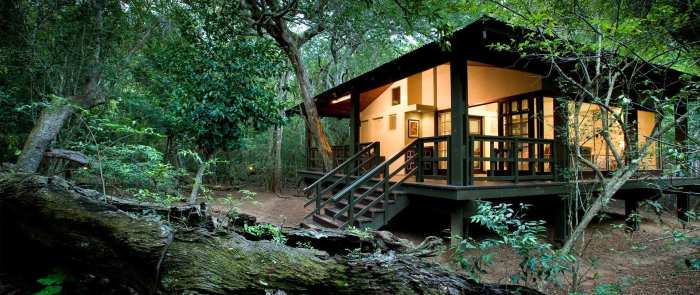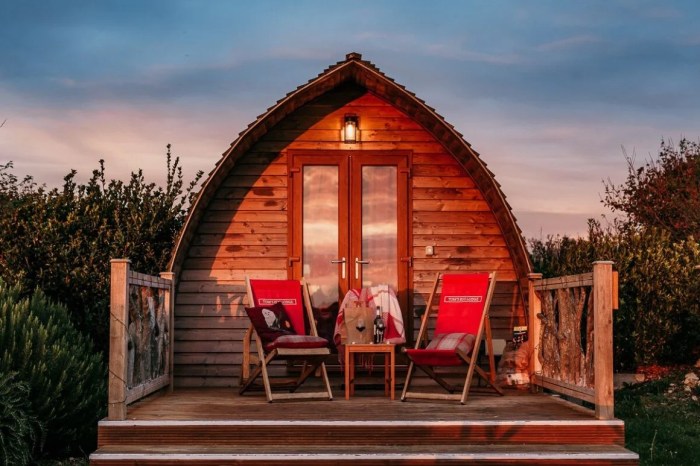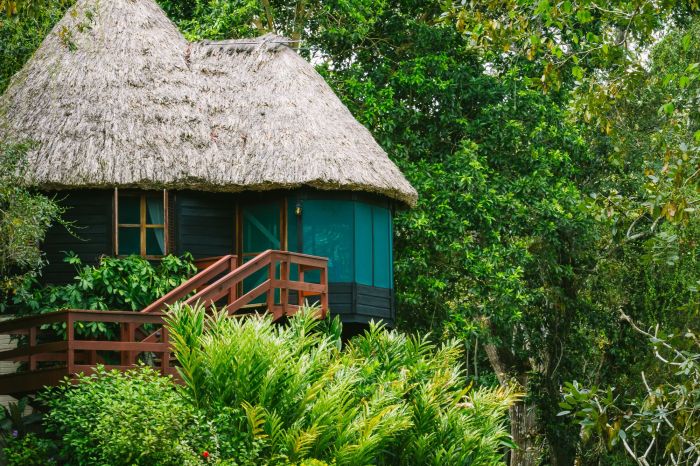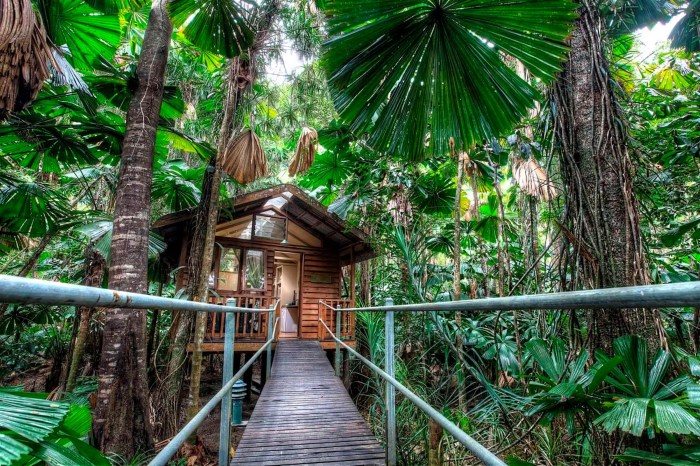Eco-lodges, havens of sustainable tourism, beckon travelers seeking an immersive and eco-conscious experience. These unique accommodations seamlessly blend into their natural surroundings, offering guests a profound connection to nature while promoting environmental conservation.
From secluded rainforest retreats to beachfront sanctuaries, eco-lodges worldwide showcase innovative design principles and sustainable practices. They serve as living examples of responsible tourism, inspiring travelers to embrace a greener lifestyle while enjoying the wonders of the natural world.
Eco-lodge Definition and Concept

Eco-lodges are accommodations that prioritize environmental sustainability and social responsibility. They are designed to minimize their ecological footprint while providing guests with a unique and immersive nature-based experience.
Key characteristics of eco-lodges include:
- Use of sustainable building materials and construction techniques
- Energy efficiency and renewable energy sources
- Water conservation and waste management systems
- Support for local communities and conservation efforts
- Education and interpretation programs for guests
Examples of Eco-lodges Worldwide
Numerous eco-lodges around the world showcase innovative approaches to sustainable tourism.
- Inkaterra Reserva Amazonica in Peru: A rainforest lodge with treehouses, canopy walkways, and a focus on wildlife conservation.
- Fogo Island Inn in Canada: A luxury lodge built from locally sourced materials, featuring geothermal heating and a strong connection to the surrounding community.
- Bambu Indah in Indonesia: A bamboo-built lodge in the jungle, offering eco-tours and traditional Indonesian experiences.
Sustainable Practices in Eco-lodges

Eco-lodges embrace environmental sustainability as a core principle, implementing various practices to minimize their impact on the surrounding ecosystem. These practices encompass reducing carbon footprint, conserving water resources, and managing waste responsibly.
To mitigate carbon emissions, eco-lodges employ renewable energy sources such as solar panels, wind turbines, and hydropower systems. They also prioritize energy efficiency through the use of energy-saving appliances, LED lighting, and natural ventilation. Additionally, they promote sustainable transportation by encouraging guests to use public transportation, bicycles, or electric vehicles.
Eco-lodges offer a unique and sustainable way to experience nature. They often feature rustic accommodations and focus on minimizing their environmental impact. If you’re planning a trip to an eco-lodge, consider using a travel itinerary template to help you plan your行程.
This will help you make the most of your time and ensure that you don’t miss any of the highlights. Eco-lodges often offer a variety of activities, such as hiking, biking, and wildlife viewing. They can also be a great place to relax and unwind in a peaceful and natural setting.
Water Conservation
Eco-lodges implement water-saving measures to preserve precious water resources. Low-flow showerheads, faucets, and toilets are commonly installed to reduce water consumption. Rainwater harvesting systems collect and store rainwater for irrigation, laundry, and other non-potable uses. Furthermore, eco-lodges educate guests on water conservation practices, encouraging them to minimize water usage during their stay.
Waste Management
Eco-lodges adopt responsible waste management strategies to minimize their environmental footprint. Waste is segregated into recyclable, compostable, and non-recyclable categories. Compostable waste, such as food scraps and organic materials, is composted on-site and used as fertilizer for gardens. Recyclable materials, including plastic, paper, and glass, are collected and sent to recycling facilities. Non-recyclable waste is disposed of responsibly through designated waste management services.
Economic and Social Impacts of Eco-lodges

Eco-lodges, by embracing sustainable practices, contribute significantly to the economic and social well-being of local communities. They provide employment opportunities, support local businesses, and promote cultural preservation, fostering a positive relationship between tourism and the environment.
If you’re seeking a unique and sustainable travel experience, consider eco-lodges, which blend seamlessly with their natural surroundings. Immerse yourself in the beauty of these destinations, from the lush rainforests of Costa Rica to the breathtaking landscapes of Patagonia. Explore best travel destinations 2024 and discover the enchanting allure of eco-lodges, where comfort and conservation intertwine.
Economic Benefits, Eco-lodges
- Job Creation: Eco-lodges create employment opportunities for local residents, from management positions to housekeeping and guiding roles.
- Support for Local Businesses: Eco-lodges often source supplies and services from local businesses, such as food, beverages, and transportation, boosting the local economy.
- Revenue Generation: Tourism revenue generated by eco-lodges contributes to local government budgets, supporting infrastructure development and social programs.
Social Impacts
- Cultural Preservation: Eco-lodges often incorporate local culture into their design, activities, and dining experiences, promoting cultural heritage and traditions.
- Education and Awareness: Eco-lodges can serve as educational platforms, raising awareness about environmental conservation and sustainable practices among guests.
- Community Involvement: Eco-lodges often engage with local communities through outreach programs, supporting schools, health clinics, and other initiatives.
Design and Architecture of Eco-lodges

Eco-lodges prioritize harmonizing with their natural surroundings through thoughtful design and architecture. They often feature organic forms, earthy tones, and sustainable materials that blend seamlessly into the landscape.
Principles of Eco-lodge Design
Eco-lodge design emphasizes minimizing environmental impact while maximizing guest comfort. Key principles include:
– Sustainability: Utilizing renewable resources, energy-efficient systems, and biodegradable materials.
– Biomimicry: Drawing inspiration from natural forms and ecosystems to create structures that mimic the surrounding environment.
– Integration: Blending buildings into the landscape, using natural materials and vegetation to create a cohesive aesthetic.
Examples of Seamless Eco-lodges
Numerous eco-lodges exemplify these design principles:
– Bambu Indah, Bali, Indonesia: Bamboo structures nestle amidst lush greenery, with open-air walkways and thatched roofs that echo the traditional architecture of the region.
– Finca Bellavista, Costa Rica: Treehouses perched on stilts overlook the rainforest canopy, providing guests with an immersive jungle experience.
– Six Senses Zil Pasyon, Seychelles: Villas and suites are designed to resemble local granite boulders, blending into the rugged landscape while offering panoramic ocean views.
Guest Experience and Amenities

Eco-lodges offer unique guest experiences that connect travelers with nature and promote relaxation. They provide opportunities for guests to immerse themselves in the surrounding environment through guided tours, nature walks, and wildlife viewing. These experiences foster a deeper appreciation for the natural world and create lasting memories.
Amenities and Activities
Eco-lodges often feature amenities and activities that enhance the guest experience and promote relaxation. These may include:
– Eco-friendly accommodations: Lodges are typically constructed using sustainable materials and energy-efficient practices, providing a comfortable and environmentally conscious stay.
– Nature-focused activities: Guided hikes, wildlife safaris, and birdwatching excursions allow guests to explore the surrounding ecosystem and learn about local flora and fauna.
– Relaxation areas: Outdoor decks, hammocks, and swimming pools offer tranquil spaces for guests to unwind and soak in the natural surroundings.
– Dining options: Many eco-lodges offer locally sourced and organic cuisine, providing a culinary experience that complements the natural setting.
Marketing and Promotion of Eco-lodges

Eco-lodges cater to a growing niche of travelers seeking sustainable and eco-conscious experiences. Effective marketing strategies should focus on highlighting the unique eco-friendly aspects of these lodges while targeting the right audience.
Eco-lodges, as part of sustainable travel destinations , offer a unique way to experience nature while minimizing environmental impact. By prioritizing eco-friendly practices, these lodges provide comfortable accommodations while preserving the surrounding ecosystems, promoting local economies, and creating awareness about conservation efforts.
Target Audience
- Nature enthusiasts and eco-tourists
- Conscious travelers seeking sustainable accommodations
- Couples and families looking for unique and immersive experiences
Effective Marketing Strategies
Successful marketing campaigns for eco-lodges emphasize their commitment to sustainability, conservation, and cultural preservation.
- Content marketing: Create engaging blog posts, articles, and videos that showcase the lodge’s eco-friendly practices, local culture, and wildlife.
- Social media marketing: Use platforms like Instagram and Facebook to share stunning images and videos of the lodge’s natural surroundings, amenities, and sustainable initiatives.
- Partnerships with travel agencies: Collaborate with eco-friendly tour operators and travel agencies that cater to travelers interested in sustainable tourism.
Successful Marketing Campaigns
Several eco-lodges have implemented innovative marketing campaigns that have garnered attention and increased bookings.
- Lapa Rios Ecolodge (Costa Rica): Launched a “Rainforest Carbon Offset” program, allowing guests to offset their travel emissions and support local conservation efforts.
- Inkaterra Reserva Amazonica (Peru): Partnered with National Geographic to offer immersive rainforest experiences and promote sustainable tourism in the Amazon.
Epilogue

As the demand for sustainable travel grows, eco-lodges continue to emerge as beacons of environmental stewardship. They not only provide unforgettable experiences but also contribute to the preservation of biodiversity, support local communities, and raise awareness about the importance of eco-tourism. As we embrace a more conscious approach to travel, eco-lodges stand as testaments to the harmony between nature and human exploration.
Common Queries
What are the key characteristics of eco-lodges?
Eco-lodges prioritize environmental sustainability through practices like reducing carbon footprint, conserving water, and managing waste responsibly. They often incorporate local materials and traditional building techniques to minimize their impact on the surrounding ecosystem.
How do eco-lodges contribute to local communities?
Eco-lodges create employment opportunities, support local businesses, and contribute to the preservation of cultural heritage. They engage with local communities to ensure that tourism benefits the region while respecting traditions and customs.
What types of amenities can guests expect at eco-lodges?
Eco-lodges offer a range of amenities that enhance the guest experience while minimizing environmental impact. These may include eco-friendly toiletries, locally sourced cuisine, guided nature walks, and activities that promote relaxation and connection to the natural surroundings.